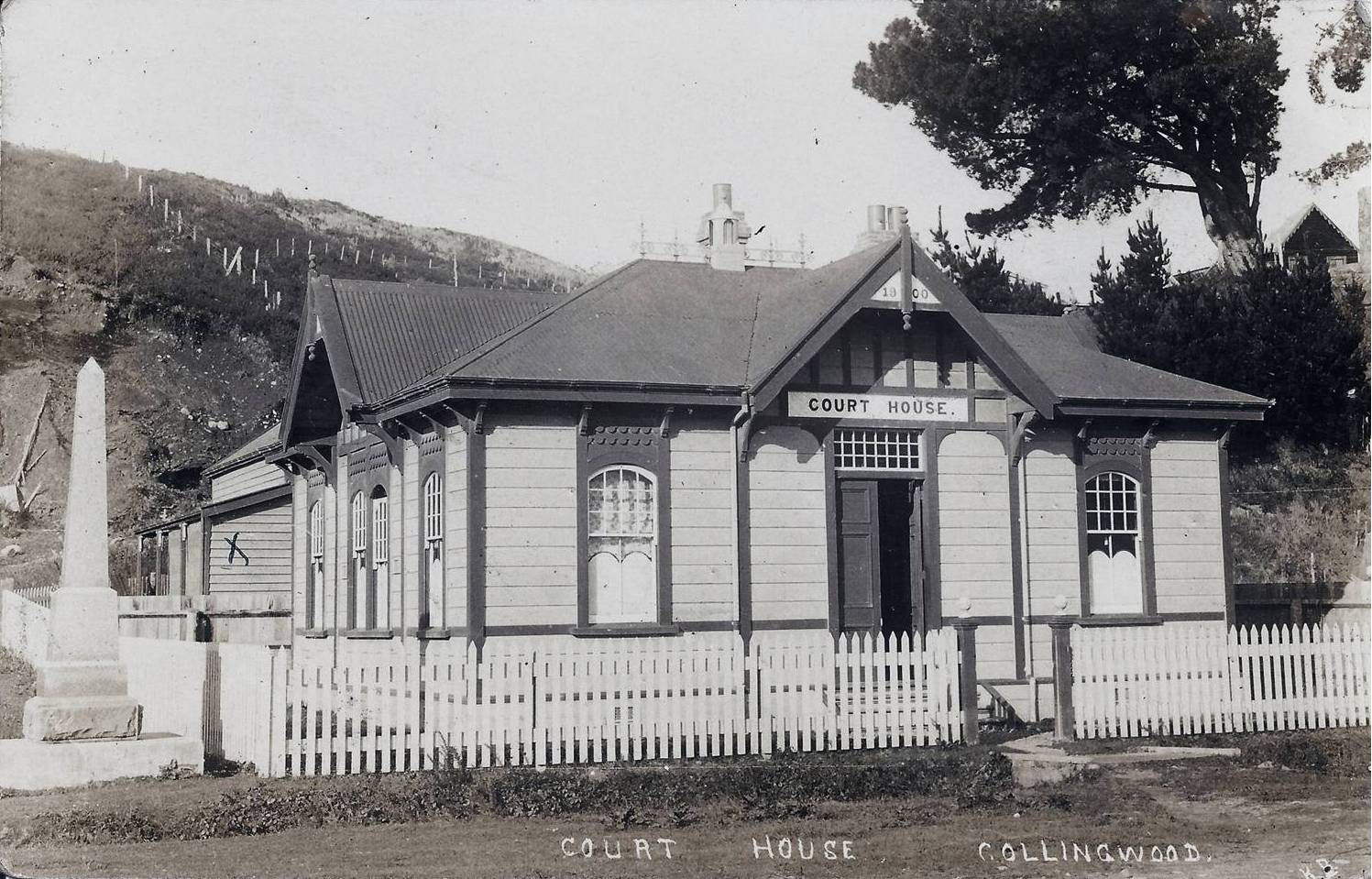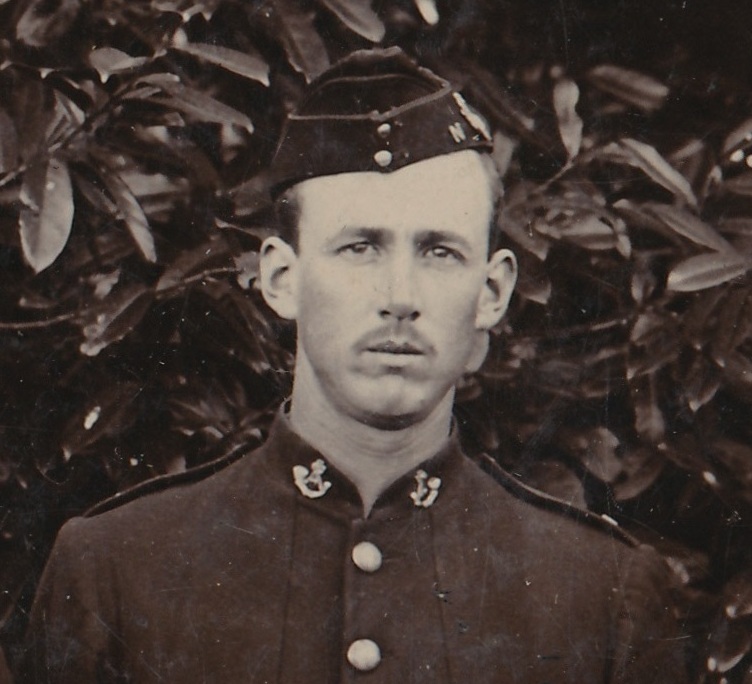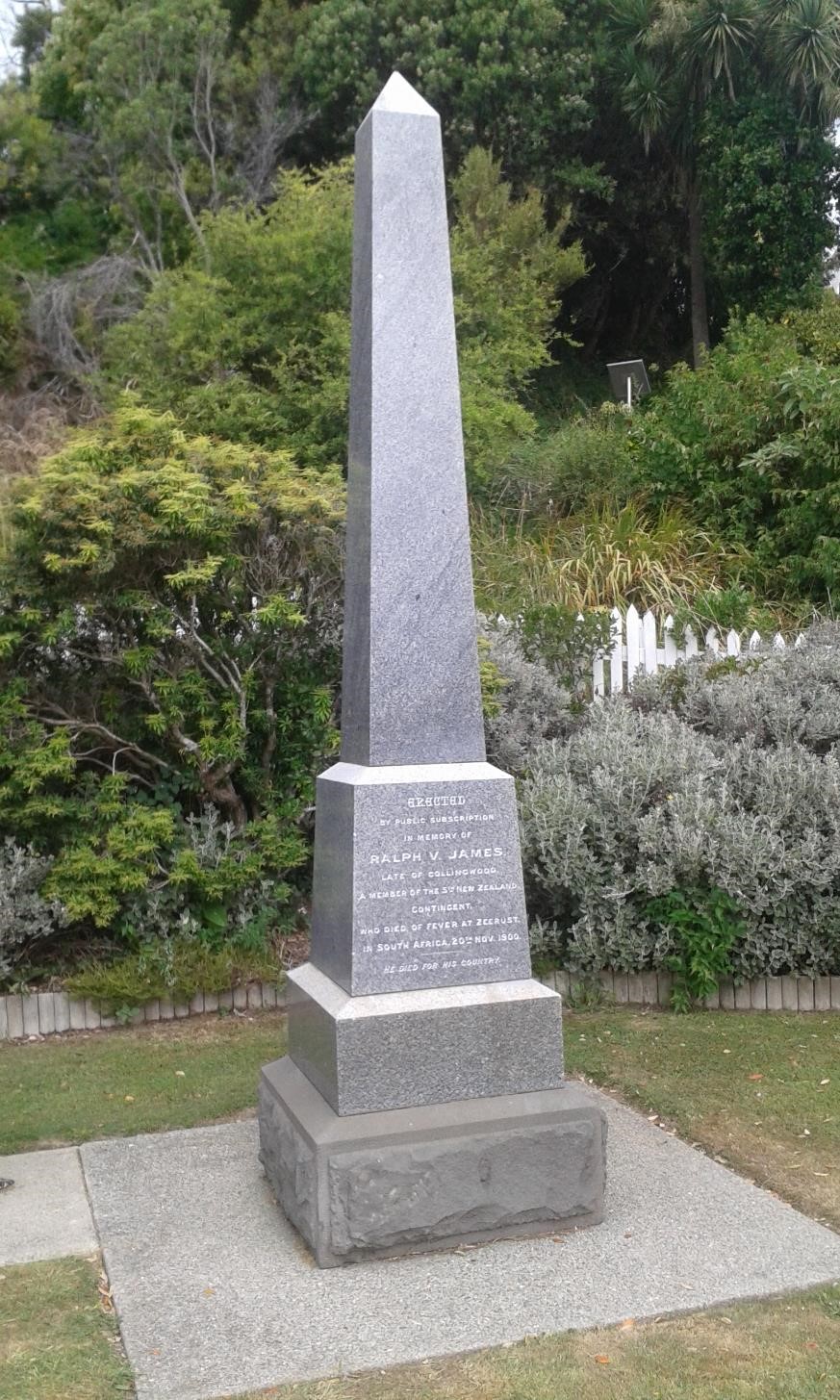Trooper Ralph Vincent James and his Monument
Collingwood lad, Trooper Ralph Vincent James 2483, died of enteric fever (typhoid fever) on 20 November 1900 at Zeerust Transvaal, South Africa while serving in the Boer War for the Fifth Contingent of New Zealand.
Collingwood lad, Trooper Ralph Vincent James 2483, died of enteric fever (typhoid fever) on 20 November 1900 at Zeerust Transvaal, South Africa while serving in the Boer War for the Fifth Contingent of New Zealand. Following public subscription, a monumental obelisk was unveiled to the Memory of Ralph James, beside the Court House in Collingwood.
Ralph was born in 1878, making him 22 when he died. His father, Frank James, and his mother, Jane Mary Skilton, were married on 3 September 1877 at the residence of Mrs Johnson, in Beachville Nelson. Both Frank, born 1855, and Jane, born 1856, were from Collingwood. Frank farmed at Puramahoi.
Ralph's grandfather, John James, arrived in Nelson as a 12 year-old, on 1 February 1842 aboard the Fifeshire. On 24 May 1854 John married Mary Ann Roil at Stoke, Nelson. Mary Ann arrived in Nelson, as a ten year-old, on the 15 March 1842 aboard the Bolton.
Ralph, his father and grandfather were all gold miners at various stages, in the alluvial gold areas around Collingwood. Grandfather John James, his brother Edward (Ned) James and John Ellis, were responsible for discovering gold in the Aorere in July 1856 at the point below what later became known as Lightband's Gully. John and Edward came to Collingwood on the cutter “Supply” on 5 August 1855. John Ellis had arrived six weeks before them.1 Bachelor Ned James became well known for his Cob house building, particularly accommodation houses in the Tophouse to Molesworth areas.
Ralph, who was the first born son in 1878, had three brothers; Llewellyn John born 1882, Frank Harold born 1890 and Roderick Roland born 1896. Tragically, following Ralph's death in 1900, a further two of his brothers were killed. He had five sisters who all married.
On Tuesday 28 May 1907, 25 year-old Llewellyn (Lou) James died in a mining accident. "On Tuesday afternoon the remains were brought down from the Slate River Sluicing Company's works to the residence of his uncle, Mr George James, on the Rockville road. In reference to the accident, it appears that the deceased was working in a tail race, when a small slip came in from the top. A stone struck him on the head and he fell into the race, meanwhile the water backed up behind the slip and drowned him, before help was obtained. When the water was let off there was no debris on his body".
Frank (Chum) Harold James served his time as an engineer at the Anchor Foundry in Nelson and was employed at Tarakohe Cement works for 12 months as an engineer. He arrived in England a few days before war was declared and joined a troopship to Australia which subsequently visited several times.2 Twenty seven year-old Frank, Third Engineer on S.S Seistan was killed, when it was Torpedoed by a German submarine off the Flamborough head on the east coast of England. SS Seistan was a 4,238 Ton steam powered collier and was transporting coal to Alexandria. It was torpedoed by German submarine UB 57, at 3.50pm on 23 October 1917. Without warning the torpedo struck the starboard side below the water line, level with the engine room. The ship was practically blown to pieces where the explosion occurred, which killed Frank and four crewmen. The ship complement was 59 crew. The crew abandoned ship immediately and the ship sank within 12 minutes. They were picked up and landed at Bridlington with five injured crew. The submarine had been hiding in shore of them and was never seen before or after the attack.3
The three brothers are acknowledged together with the same grave head stone, in the James plot at Collingwood cemetery.
The fourth son, Lance Corporal Roderick Roland James 55599, was listed as a farmer in Puramahoi and was part of the 29th Reinforcements. He departed from Nelson on 28 May 1917. He survived the war and returned to Wellington on the Corinthic on 22 September 1919. He married and went on to have a family.
In June 1898, two years before his war service, Ralph sustained an injury at the Quartz Range, near the Aorere, when an axe slipped and inflicted a large deep wound in the instep of his foot. Mr Mace, the manager of the Collingwood Goldfields Company's works, skilfully sowed the wound. He was expected to be alright in a few weeks time.
When the South African war began there were two local fund raising efforts to provide uniforms and equipment for the Nelson troop contingents. The “More Men” Fund and the “Patriotic Fund” were two initiatives which were operating in the Nelson Province. Fund raising included workplace and club donations and a concert. One of many workplace donations was £9 1s from the Collingwood Gold Fields Employees at the Quartz Range. This included a donation from Ralph.
Men who wanted to volunteer for the Fifth Contingent travelled to Nelson to undertake testing for selection. This included a medical fitness examination with the testing of horse riding and rifle firing skills. Ralph James was selected on 18 March 1900 and was listed as being part of the Stoke Rifles, but from Collingwood. A total of 13 were selected from Nelson, with two of those men already being in Wellington.
Nelson 19 March 1900. There was very little fuss and no formal demonstration made over the departure of the 11 men who left by the Wainui yesterday for Wellington to join the Fifth Contingent as Nelson's contribution. Still the men were not allowed to go away without some evidence that they took with them, the good wishes of the citizens, some patriotic citizens saw that horses were provided, so that the men, under Quarter-Master Coleman, were mounted. They assembled near the Drill Shed, marched to the Church Steps, and thence made their way to the Port, a number of citizens following in vehicles, and some cyclists. On the Haven road the Garrison Band, just returned from Wellington by the Mapourika, met the contingent and played them to the wharf where a large crowd had assembled. We should mention also that a number of Stoke and Waimea Rifles, in uniform, took part in the proceedings and included among the crowd were a considerable number of the town Volunteers, not in uniform. On the wharf, cheers were given for the Nelson men, and also for the West Coast men on the Wainui, also on their way to the central camp. The West Coasters acknowledged the compliment with cheers for the Nelson men, and the Band, as a final contribution, played "Auld Lang Syne."4
Ralph’s details on his attestation form signed on 28 March 1900 outline the following; Occupation gold miner, Employer Collingwood Goldfields Company, Age 21 years & 5 months, Height 5’ 11”, Chest 38”, Weight 12st 6lbs, Religion Church of England, Next of Kin Father Frank James.5
Wellington 31 March 1900. The weather is fine for the send-off to the Fifth Contingent today and the afternoon will be a general holiday. There is an absence of country people and the numbers to witness the departure will not be so great as on former occasions. The men were busy this morning breaking camp and shipping the horses. At eleven o'clock the Contingent began the march from Newtown Camp to the Skating Rink, where they will be entertained at luncheon by the citizens. After luncheon the men will march direct to the steamers Waimate and Maori, and the work of embarkation is expected to finish by 3.30 p.m and the troopships leaving by 4 o'clock. Thirteen steamers will accompany the troopship down the harbour. Including the additional men who were passed by the Premier today nearly 500 men have gone. The exact figures being; "Waimate";13 officers, 268 men, 233 horses. "Maori"; 8 Officers 200 men, 180 horses. It will thus be seen that there are 55 more men than horses, as it was, of course, impossible to obtain sufficient chargers at the last moment. The Fifth Contingent arrived in Durban on 5 May 1900.6
Ralph died of typhoid fever, which is characterised by high fever, intestinal inflammation and is spread by food or water contaminated with the bacillus Salmonella typhosa. Many soldiers died needlessly during the South African War from diseases, which also included dysentery and pneumonia. During this period there were no antibiotics to treat these diseases.
Men employed at the Collingwood Goldfields Company, at the Quartz Ranges, each gave a day's pay towards the fund for erecting the memorial and £10 were so raised.7 The Takaka Mounted Rifles also contributed.8 About £50 were raised for the memorial. In addition to this the Foresters Lodge raised £16 to place a memorial tablet in their Court room.9
Memorial to Late Trooper James. Mr G.M.Simpson, monumental sculptor has just completed to the order of the Collingwood Foresters, a wall tablet to be placed in the Institute, Collingwood, in memory of the late Trooper Ralph James. The tablet takes the form of a scroll in marble, and bears the following inscription in permanent lead filled characters. "This tablet was erected by Court Aorere, A.0.F., No 5683, Collingwood, in memory of their late Brother, Ralph V. James, member of the Fifth New Zealand Contingent, who died at Zeerust, South Africa, 20th November, 1900, while serving his Queen and Country in the Boer War, March, 1901."10
On 9 November 1901, the handsome memorial erected near the new Court house (1900) to commemorate the late Trooper Ralph James, was unveiled in the presence of a large number of people, the Takaka Mounted Rifles, under the command of Lieutenants Kirk and Fittal, being also in attendance. The monument, which cost over £50, stands 13ft high, is of Aberdeen grey granite with a bluestone base, and bears the following inscription; "Erected by public subscription in memory of Ralph V. James, late of Collingwood, a member of the Fifth New Zealand Contingent, who died of fever at Zeerust in South Africa 20th November 1900." "He died for his country".
Mr Frank Stallard Snr (Ralph’s uncle), on behalf of the subscribers, requested Mr F.G.Mace to unveil the memorial. Mr Mace, in conducting the ceremony, referred to the late trooper in feeling terms, and said that though he had not died in actual battle, yet he had laid down his life for his country, and Collingwood was proud to do honour to his memory and to show his parents and relatives the esteem in which he was held. Mr Stallard then thanked the public for their attendance and after a few words from Mr G.P.Graham (One of the pioneer settlers of Bainham, and one of the founders in 1873 of Court Aorere A.O.F.), the gathering dispersed.11
In 199312 the monument was moved 60m from the east side of the court house to the small local purpose war memorial reserve near the church hall. This reserve includes a WWI monument and a monument to WWI Army Lieutenant Harry Bolton Riley.13
In October 1999 The Guardian Newspaper featured the James family descendants gathered at Ralph's memorial, to remember 100 years since he died. A photo taken at the memorial featured the family members. An extract from a letter written by Ralph to his grandfather reads, "There are plenty of oranges and lemons here, very large groves. You can guess pretty well what they are like when 1,000 men have had all they want and then you can't see where they have been....It is very hot and dusty out here."14
2016
Updated May 20, 2020
Story by: Ken Wright
Sources
- A Collingwood pioneer (1910, March 28) Colonist, p.2
- Palmer, G.L. (1983) Family History of Edward and Sarah James Thomas and Sarah Roil and their descendants, p. 77
- www.wrecksite.eu/wreck.aspx?65624
- The fifth contingent (1900, March 20) The Colonist, p.3
- NZ Archives, Fifth Contingent For Service In South Africa 55 Ralph Vincent James
- War News (1900, April 2) Hawera & Normanby Star, p.2
- Memorial To The Late Trooper R James (1900, November 29) Colonist, p.4
- The Late Trooper James (1900, December 17) Nelson Evening Mail, p.2
- Collingwood Notes (1901, March 28), Nelson Evening Mail, p.4
- Memorial To Late Trooper James (1901, May 4) Colonist, p.4
- The Ralph James Memorial (1901, November 14) Nelson Evening Mail, p.4
- Tasman District Council File 11711 “Local Purpose Reserve War Memorial”
- nzhistory.net.nz/media/photo/collingwood-south-african-war-memorial
- Collingwood family remembers Boer War casualty 100 years ago (1999, October 25) The Guardian
Further Sources
Books
- Palmer, G.L. (1983) Family history, Edward and Sarah James, Thomas and Sarah Roil and their descendants. Nelson [N.Z.] : [G.L. Palmer], 1983
http://www.worldcat.org/oclc/154202814 - Petyt, C (2003) Collingwood: the old cemetery and early history. Takaka, N.Z. : Terracottage Books
http://www.worldcat.org/oclc/155888428
Newspapers
- Wright, K. (2016) A Boer War Memorial - Trooper Ralph Vincent James. Journal of the Nelson and Marlborough Historical Societies, 8(2), 45-51
Websites
- 'Collingwood war memorials'. (Ministry for Culture and Heritage), updated 20-Dec-2012
http://www.nzhistory.net.nz/media/photo/collingwood-war-memorial - Ralph Vincent James on Online Cenotaph:
http://www.aucklandmuseum.com/war-memorial/online-cenotaph/record/C17356 - SS Siestan: wreck report, retrieved 20 May, 2016 from:
www.wrecksite.eu/wreck.aspx?65624


